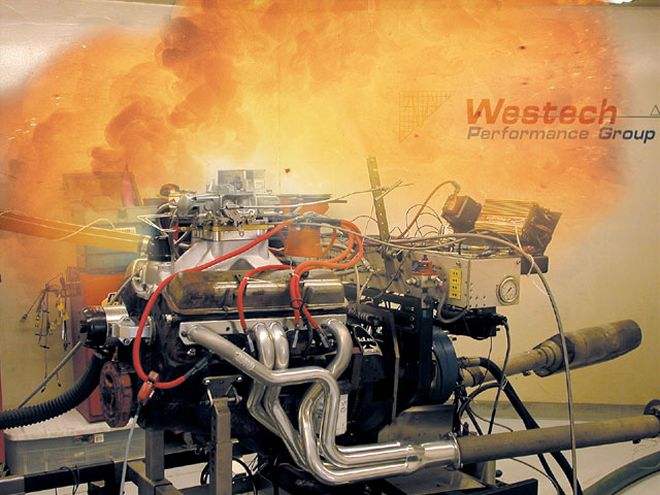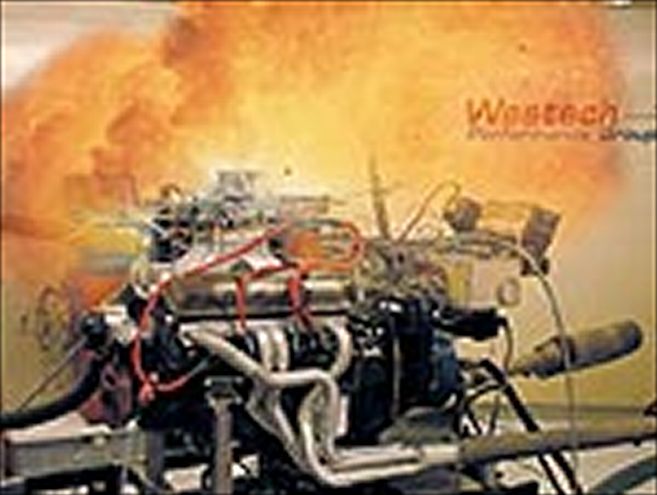


This is a story of wanton destruction. At least it started out that way. A year or so ago, when I was the editor of Chevy High Performance, we decided to see how much nitrous a stock, junkyard small-block Chevy could take before it grenaded. So we rounded up a high-mileage 350 out of a '75 Chevy from our friends at Memory Lane, a recycling yard that specializes in '73-and-earlier vehicles.
In short order, we bolted in a Comp Cams nitrous camshaft to give the little Chevy some real power potential along with new valvesprings (so it wouldn't float the valves at 4,500 rpm) and a single-plane intake to accommodate the nitrous plate. We also bolted in new Fel-Pro head gaskets in the hope the nitrous wouldn't push the gasket out before it blew up. The horsepower came in a big yellow bottle from Barry Grant's Nitrousworks in the form of a dual-stage plate kit. The maximum power we could add was 425 hp, and we figured that would be enough.
Before we could bolt the engine on the dyno, Westech's dyno man Steve Brule wanted a signed statement stating that we'd clean up the mess after the Mouse motor expired. We had a feeling that it was going to be less spectacular than that, but we humored him. After breaking in the new cam, we loaded the engine with a normally aspirated test first just to ensure the engine was going to be OK. Our paltry performer surprised us with an impressive 310 hp peak at 5,200 and 344 lb-ft of torque.
We quickly hit the engine with a one-two punch of 100hp and then 200hp nitrous hits that the engine handled without a whimper. With the 200hp kit, our mighty Mouse was steamin' at 521 hp with 587 lb-ft of torque! Next, we hit it with 300hp and saw the power shoot up to 599 hp and 655 lb-ft of torque. When we re-baselined the normally aspirated combo, our little hero small-block stepped up with 325 hp, an increase of 15 hp over the previous baseline. We attributed this to better ring seal after the nitrous knocked the carbon off the rings! Now we were ready for the big squeeze!
At this point we loaded all the nitrous the small kit would push (a 400hp shot) and got ready to really thump on this junkyard jewel. Not thinking too clearly, we also decided to internally purge the system at idle. Even just flicking the nitrous button was enough to rock the little engine almost right off the stand. Unfortunately, this little trick also knocked the ring lands off three of the cast pistons on the right bank-our day was done.
The autopsy later revealed that except for three broken pistons, the engine survived remarkably well. This is when replays of the TV show The Six-Million Dollar Man began playing in our heads: "We can make him better-we have the technology." The cylinder walls were basically undamaged, so we dumped the ailing motor at Ed Taylor's doorstep and said, "Fix it." Now that's a dangerous thing to say to our resident torque-wrench spinner, so we quickly put limits on what Ed could do our boneyard-beater.
The limits came down to adding a set of Federal-Mogul flat-top forged pistons, new 51/464-inch rings, and a set of Federal-Mogul rod and main bearings. We didn't even allow Ed to use the Sunnen machine to hone the cylinders. Instead, we forced him to use one of those bottle-brush hones. Ed added new Fel-Pro head gaskets mainly because we wanted to put as much pressure on the pistons as possible. To give the head gaskets a fighting chance against the nitrous onslaught, we also used a set of ARP head bolts and told Ed to crank down on the torque to really squeeze the gaskets. There was talk of welding the heads on, but we passed on that idea only because it sounded a bit over the top.
We decided to reuse the Comp Cams NX268 cam, 1.5 stamped rockers, and the stock heads since they survived the first flogging unscathed, as did the single-plane intake and Demon 750-cfm carburetor. From our prior experience, we figured the original dual-stage 450hp Nitrousworks kit we used the first time around would still be enough. If need be, we could always step up to one of Nitrousworks' Magnum "X" Dual Stage Systems. This system can flow up to 550 hp on the second stage, which suited us just fine.
Nuke DayAfter taking out a Westech Fragmentation Insurance policy and outfitting dyno operator Steve Brule with a Car Craft signature flak jacket, we were ready to rock 'n' roll. After talking to Steve about our last nitrous romp, we decided we would not purge the system, allowing the fuel to reach the intake and the cylinders first, creating a few nanoseconds of rich mixture that might keep our Mouse motor alive a little longer. Steve told us about research that Westech had seen using a Motech EFI system with a purged nitrous system that reportedly saw the nitrous reach the cylinder first that generated 15:1 air-fuel ratios for about 0.200 second before dropping down to a much safer ratio.
Like last time, we started with a few normally aspirated runs to establish a baseline power level. We also wanted to see if the new pistons and rings helped the horsepower since everything else was essentially the same. The rebuild was worth only a couple of ponies with the normally aspirated pulls making 330 hp at 5,600 rpm and 350 lb-ft of torque at 4,200. Keep in mind that this is with untouched stock iron castings with the Comp Cams 268 Xtreme nitrous cam, a Victor Jr. single-plane, and a Demon 750-cfm carb all running on 91-octane pump gas using an MSD 7 box and the coldest plugs we could find. We skipped over the 100hp shot and went right to the 200hp combo. The little motor thumped up to 510 hp at 5,200 rpm and an amazing 572 lb-ft of torque. That's when we decided to get greedy.
We loaded up the big pill package and cinched our steel helmets on tight. Charitable folks that we are, we felt a tinge of guilt creep in right before we fired the engine, so we decreed to the assembled throng in the dyno cell that if the small-block survived this run that we'd spare its life. After all, here was our trooper Mouse motor with its head firmly secured in the dyno cell guillotine and Steve the hatchet man poised with the button clenched in his fist. Steve ran the engine up, hit the button, and a flame the size of the Empire State Building shot up to the ceiling of the dyno cell, impacting melted aluminum from the carb's boosters on the ceiling! Clearly, our shot went dead lean, but amazingly the carb and engine survived, even if the bottom of the boosters were slightly melted.
At this point, we'll spare you the agonizing details of how we discovered that we had reached the saturation point with the nitrous. We were trying to shove 10 pounds of nitrous through a 2-pound engine bag, and it just wasn't going to work. As we eventually discovered, our stock little small-block could only breathe in a given amount of nitrous. As best we can figure, the load the engine had to exhaust didn't all make it out of the combustion chamber before it was time for the next load of nitrous to enter. The intake valve would open, and as Steve said, "It's like the intake manifold became another combustion chamber." That's when we'd see the flame shoot out the intake.
Another thing we learned was that we needed a little more fuel than the Nitrousworks sheet suggested. This is probably due to the fact that this Nitrousworks kit is intended to be used on an engine that could actually accept all that nitrous and fuel and make power with it-our engine couldn't. But we found that by increasing the fuel jet, we could keep the spark plugs alive long enough to make some power. We learned all this at the cost of something close to three sets of spark plugs and well over 30 pounds of nitrous.
Once Steve finally got a handle on the nitrous tuning, we found that a 250hp shot from the one big solenoid on the kit was the most our engine could accept without shooting flame out the intake or devouring spark plugs. Our last best shot before the ring lands again disintegrated was a rewarding 600 lb-ft of torque at 4,900 rpm and 570 hp at 5,200. If you note the rather low rpm where peak horsepower occurs, it's a major clue to why this engine wouldn't make any more power no matter how much nitrous we put to it. Adding more nitrous resulted in a small cloud of air and fuel that hovered over the carburetor inlet at around peak power. This is a phenomenon called "stand-off" where the inlet manifold is so pressurized by reversion pulses in the intake that air and fuel are forced back up the carburetor venturis, collecting in a cloud at the point where the pressure equalizes. When we saw that, we knew we were done.
So what did we learn? We originally just wanted to break something in an automotive version of Punk'd. But what we discovered, and what the nitrous companies later informed us, is that achieving a 100 percent power increase from a relatively stock engine is very difficult. Since the engine made 330 hp in its normally aspirated state, we managed to get close by adding a total of 240 hp to come up with our peak of 570 hp. But even here, the engine didn't survive, and we again nipped a ring land even with the stronger forged pistons.
Since our engine has survived this long, we've decided not to put it out to pasture just yet. We've got some other plans for our junkyard dog. Who knows, with a decent set of heads and a different cam and intake, we might just see how much grunt this dog can pump out. Stay tuned.
Test HP Torque Baseline, normally aspirated 330@5,600 350@4,200 Added 200hp nitrous 540@5,200 572@4,400 Added 250hp shot 570@5,200 600@4,900
Parts ListAll prices are from www.summitracing.com
Component Company Part Number Price Two-stage Nitrous kit Nitrousworks 12065 $663 750-cfm carburetor Demon 1402010 440 Intake manifold, Victor Jr. Edelbrock 2975 180 Distributor MSD 85561 226 Ignition wires MSD 3165 50 Camshaft and valvetrain kit Comp K12-560-4 341 Rockers, 1.5:1 Comp 12-12-16 115